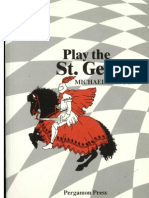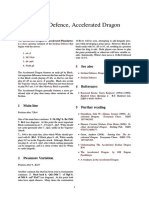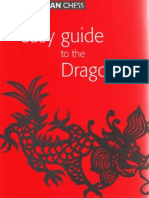Sicilian Sacrifice - Chess Cafe
Sicilian Sacrifice - Chess Cafe
Uploaded by
antonius-raducuCopyright:
Available Formats
Sicilian Sacrifice - Chess Cafe
Sicilian Sacrifice - Chess Cafe
Uploaded by
antonius-raducuCopyright
Available Formats
Share this document
Did you find this document useful?
Is this content inappropriate?
Copyright:
Available Formats
Sicilian Sacrifice - Chess Cafe
Sicilian Sacrifice - Chess Cafe
Uploaded by
antonius-raducuCopyright:
Available Formats
The Instructor
The
Instructor
Mark Dvoretsky
Simagin's Exchange Sacrifices
Today, the positional exchange sacrifice Rxc3! in the Sicilian Defense has
become a standard tactic that has probably been employed in thousands of
games. But at one time it was an innovation, and one of the first players to make
use of it was Vladimir Pavlovich Simagin. He wasnt terribly strong as a player
perhaps a middling grandmaster but the depth of Simagins ideas and the rich
creativity of his play stood out, even compared to players who achieved
considerably greater successes. Let me present some examples from Simagins
Best Games, based upon his laconic annotations (given in italic). A question
mark next to the diagram indicates that you can use the position as an exercise
for solving.
Ravinsky Simagin
Match-tournament Championship of Moscow, 1947
1.e4 c5 2.Nf3 d6 3.d4 cd 4.Nxd4 Nf6 5.Nc3 g6 6.Be2 Bg7 7.0-0 0-0 8.Nb3
Nbd7 (8...Nc6) 9.Kh1 b6 10.f4 Bb7 11.Bf3 Rc8 12.Be3?!
B?
12...Rxc3!
A universal exchange sacrifice in the Sicilian
Defense. Black obtains just one pawn for the
exchange, but all of his pieces will take up
excellent positions. In the sharp middlegame
fight that follows, Blacks minor piece will be
no weaker than Whites rook.
13.bc Nxe4 14.Bd4 e5 15.fe de 16.Qe1?!
The complications created by White lead to a decisive advantage for his
opponent! But after 16.Bxe4 Bxe4 17.Be3 Bc6!, Black would still have a great
positional advantage, in Simagins opinion.
16...ed 17.Bxe4 Re8 18.Bxb7 Rxe1 19.Raxe1 dc 20.Re3 h5!
The decisive moment: Black secures his kings safety, after which his
material advantage decides the game.
file:///C|/cafe/Dvoretsky/dvoretsky.htm (1 of 11) [10/9/2006 6:40:00 PM]
The Instructor
21.Ba6 Ne5 22.Rxc3 Kh7 23.Rh3 Qd5 24.Bd3 Kg8! 25.Re3 Bh6 26.Rg3 h4
27.Rh3 Bg5 28.Be2 a5 29.Nc1? Bxc1 30.Rxc1 Qd2 0-1
Blacks exchange sacrifice turned up in many events to follow, eventually
becoming a rather routine strategic technique, by which Black destroys
the white center. However, Master Ravinsky was evidently not convinced
of the correctness of Whites strategy: ten years later, the following game
was played between us.
Ravinsky - Simagin
Moscow 1957
W
In this position, White could have played
13.Nd2!, supporting his pawn center.
13.Bd4? Rxc3! 14.bc?! Nxe4 15.Nd2 Nxd2
16.Qxd2 Bc6 17.c4 Qc7 18.Rad1 b6 19.Rf2
Ba8 20.h3 gf! 21.gf Kh8 22.Kh2 Rg8 23.Rg1
Qc6 24.Qg5 Qe4 25.Be3?
After 25.f6! ef 26.Qd2 f5, Blacks position
would be preferable, but the fight would
continue.
25...Ng4+!! Black wins the queen and the game.
Earlier still, Simagin discovered a different setup for his positional exchange
sacrifice. Nowadays this can also be called typical, but it comes up far less
frequently. I can count the number of examples known to me on the fingers of
one hand.
Ljublinsky Simagin
Moscow, match 1939
1.e4 e5 2.Nf3 Nc6 3.Nc3 d6 4.d4 ed 5.Nxd4 g6 6.Be3 (6.Bb5) 6...Bg7 7.Be2
Nge7
Usually in such positions, Black develops his knight to f6.
8.Qd2 0-0 9.h4
It would probably have been a good idea to castle long first, and only then play
h2-h4. Black meets the immediate flank attack as hes supposed to with a
counterattack in the center.
9...d5! 10.Nxc6 bc 11.0-0-0 Be6 12.Bh6?!
file:///C|/cafe/Dvoretsky/dvoretsky.htm (2 of 11) [10/9/2006 6:40:00 PM]
The Instructor
Had White foreseen the complications which follow, then of course he
would have played 12.Bd4, retaining a decent position.
12.h5!? was also worth a look.
B?
12...Bh8!
Similar exchange sacrifices have occurred a
few times in my games. In a complex
middlegame, an active black bishop is of
course no weaker than a passive white rook.
Nevertheless, it should be noted that such
sacrifices are not always correct. In the
present position, a number of factors may be
defined as allowing me to predict that Blacks
attack will be almost impossible to withstand. The most significant factors
are these: 1) the open b-file, along which the remaining black rook will
soon be operating; and 2) the mobile pawn center, which will soon be set
in motion.
13.Bxf8 Qxf8 14.a3?
White had intended to attack, but must instead go on the defensive. The
change of circumstance had a deleterious effect on him, and now he loses
time. 14.Na4 was better.
In reply to 14.Na4, Black would play 14...de, with excellent compensation for the
sacrificed exchange even though, Simagins opinion notwithstanding, I have
some doubts as to the irresistibility of Blacks attack. Another natural
continuation for White would have been 14.h5.
14...Rb8 15.Bd3 c5! 16.ed?!
Here, too, 16.h5 was worth consideration.
16...Nxd5 17.Na4 Bd7!+18.Qa5 Bxa4 19.Qxa4 Qh6+20.f4 Nxf4 21.Rd2
Bxb2+22.Kd1 Bc3 23.Rf2 Rb1#0-1
A similar positional exchange sacrifice occurred in the game Byvshev Tolush,
USSR Championship semifinal, Leningrad 1954, which can be found in the
exercise section of Dvoretsky and Yusupovs School of Future Champions 1.
All of the above serves as an introduction to the following game. Its far from
error-free, but it was a very tense and interesting game. I hope you will like some
of the ideas that I discovered during my analysis.
Panov Simagin
Moscow Championship 1943
file:///C|/cafe/Dvoretsky/dvoretsky.htm (3 of 11) [10/9/2006 6:40:00 PM]
The Instructor
1.e2-e4 c7-c5 2.Ng1-f3 d7-d6 3.d2-d4 c5xd4 4.Nf3xd4 Ng8-f6 5.Nb1-c3 g7-g6
6.Bc1-e3 Bf8-g7 7.f2-f3 0-0 8.Nd4-b3?!
An inferior move; now White no longer has any reason to expect an opening
advantage. The usual continuation is 8.Qd2.
8...Bc8-e6 9.Qd1-d2 Nb8-d7 10.0-0-0 Nd7-b6 11.g2-g4 Ra8-c8 12.Be3-h6
B?
12...Bg7-h8?!
Simagins following note gives us insight into
his objectivity and his creative tastes, to
which he remained faithful his whole life.
In this position, the exchange sacrifice cannot
be considered completely correct. In my game
against Ljublinsky, the sacrifice gave Black a
clear strategic benefit. But here, we have no
reason to assert that the game must finish with a driving attack. If the
sacrifice can be considered reasonable, then it is only on psychological
considerations. Master Panov is an excellent attacker, but considerably
worse in games requiring lengthy defense.
I dont rate games with such psychological nuances very highly. A chess
master, in my view, should play consistently, and strive for error-free
games. I include this game here only because it was published in many
places, but it has never received the proper annotation.
And how should he have played? In ECO, Efim Geller suggests 12...Bc4, with
the idea of securing the important c4-square for the knight, but I dont find this
recommendation convincing.
In my view, the positional exchange sacrifice noted at the beginning of this
article suggests itself: 12...Bxh6 13.Qxh6 Rxc3! 14.bc Qc7, with full
compensation, given the weakness of the queenside pawns.
Why didnt Simagin play this? Look at the date: he was aware of the Bg7-h8!?
idea, because he had played it four years earlier. But the positional sacrifice of
the exchange on c3 wasnt employed by him for another four years: in 1947. This
is why it seems obvious now because we have seen it in a number of analogous
examples. To be the first to find such an idea over the board is very difficult
indeed.
For gourmands, I offer the suggestion to examine a transposition of moves:
12...Rxc3!?. It has no independent significance, since after 13.bc, Blacks best
line would be to return to the same position by 13...Bxh6 14.Qxh6 Qc7. But
file:///C|/cafe/Dvoretsky/dvoretsky.htm (4 of 11) [10/9/2006 6:40:00 PM]
The Instructor
White has an additional possibility: 13.Bxg7, to which Black would reply
13...Rxf3.
W
On 14.Bxf8 Qxf8, Blacks compensation for
the exchange is quite sufficient. But White
also has a rather unusual idea at his disposal:
14.Bxf6!? Rxf6 15.g5, when the rook is
trapped. On 15...Rxf1 16.Rhxf1, White has
the upper hand; and on 15...Rf3!, he has the
reply 16.Nd4. But here, Black can obtain
counterplay by 16...Bg4! 17.Re1! Rxf1
18.Rhxf1 e5 19.Nb3 Nc4 (unexpectedly
winning the g5-pawn) 20.Qd5 Qxg5+21.Kb1
Be6 22.Qxb7 a5, with chances for both sides (joint analysis with Vadim
Zvjagintsev).
13.Bh6xf8 Qd8xf8 14.Nb3-d4 Be6-c4 15.g4-g5 Nf6-d7 16.Bf1-h3
I am not commenting on Whites moves, because theyre good enough to retain
the advantage, although they were clearly not the best available, as he probably
could have varied somewhere.
16...e7-e6 17.Kc1-b1
B
Now how does Black continue? He would
like to clear c4 for his knight, but 17...Ba6 is
met by 18.Nxe6! And on 17...Qe7, 18.f4 Ba6
19.f5 Nc4 20.Qf2 looks strong.
GM Zvjagintsev suggested a curious
positional idea: 17...h6!? 18.gh Kh7,
diminishing the threat of the knight sacrifice
on e6, and somewhat improving his chances
in the event of later simplification, as his
pawn structure has been improved. However, the advantage still remains with
White.
Simagin attempted to solve the problem tactically, and he succeeded, but only
because of later errors by his opponent.
17...Nd7-e5 18.f3-f4!
Simagin disparages this move, recommending 18.Qf2 instead mistakenly so, in
my view.
18...Ne5-f3!
file:///C|/cafe/Dvoretsky/dvoretsky.htm (5 of 11) [10/9/2006 6:40:00 PM]
The Instructor
A clever idea.
19.Nd4xf3
White could also have declined the proffered sacrifice by 19.Qe3 Nxd4
20.Rxd4!.
Quite right. This technique, which may be labeled the cold shower (declining
to enter complications, even at the cost of returning the extra material, either
wholly or in part), must always be considered when initiating combinative
attacks. The resulting position is, in my view, markedly better for White, even
though it would require accurate play. After 20...Bxd4, 21.Qxd4 Ba6 is
unfavorable because of 22.f5. Zvjagintsevs move, 21...h6, would be justified if
White played the somewhat abstract continuation 22.Bg2?! hg 23.fg Ba6 24.h4
Nc4. But the blow 22.f5!? is also unpleasant here, and 22.Rg1 hg 23.Rxg5 Qh6
24.Qe3+/ would also be strong.
19...Bg7xc3
W?
20.b2xc3?
The watershed moment of this game!
Simagin also examined the variation 20.Qxc3
Bxa2+21.Kxa2 Rxc3 22.bc Qc8!, and later
evaluated it as favoring Black probably
correctly.
Here is another place where White could have
had recourse to the cold shower. The simple 20.Qxd6! would have left Black
nothing but to head for a pawn-down endgame: 20...Be2 21.Qxf8+Kxf8 22.Bg2
or 22.Rd3, when Black would have faced a tough struggle to draw.
20...d6-d5!
Black has sacrificed a rook, but obtained a dangerous attack. Blacks
attack was only enough to gain the draw.
21.Qd2-c1 Nb6-a4 22.e4xd5?
The text doesnt deserve the exclamation mark Simagin rewarded it with. The
position after 22.Ne5!? Bxa2+23.Ka1 Qc5 looks uncomfortable, but I believe
that White would be quite justified in anticipating a drawn outcome. Another
possibility was: 22.Ka1!? Qc5 (the immediate 22...Bxa2 would be weaker, in
view of 23.Rd4! Nxc3 24.Qb2 de 25.Ne5 Bd5 26.Qb4) 23.Nd4!? Bxa2!, with
chances for both sides.
file:///C|/cafe/Dvoretsky/dvoretsky.htm (6 of 11) [10/9/2006 6:40:00 PM]
The Instructor
22...Bc4xa2+!
22...Nxc3+23.Ka1 Bxa2 was also strong.
23.Kb1-a1
23.Kxa2? would lose to 23...Nxc3+24.Ka1 Qb4! or 24.Kb3 Qc5! (Simagin)
B?
23...Qf8-c5?
The natural move, but not the best. 23...Nxc3!
was far stronger.
How do we establish this? For White, its
positionally very important to destroy the
pawn at e6, for the bishop at h3 to go to work.
So, after the text, 24.de! was possible,
whereas 23...Nxc3! 24.de?! Bxe6 25.Bxe6 fe
would leave White defenseless. And if instead of 24.de White plays 24.d6, Black
responds 24...Bd5 25.Rxd5 (theres nothing better) 25...Nxd5, and Whites
position is difficult. Black simply threatens 26...Qxd6, and on 26.d7?! comes
26...Rc4!, with decisive threats.
24.d5xe6 Na4xc3
Here, 24...Bxe6? 25.Bxe6 fe no longer works, because of 26.Nd4. And perpetual
check, after 24...Qxc3+25.Ka2 Qc4+is also insufficient for Black.
W?
Vassily Panov could not withstand the
nervous tension of the battle and lost quickly.
25.Rd4? Bxe6 26.Bxe6 fe
There is no satisfactory defense to the
threatened 27...Qa5+.
27.Ra4 Nxa4 28.c4 Rd8 29.Ka2 Qb4 30.Re1
Rd3 31.Rxe6 Nc3+0-1
White had to choose either 25.ef+or 25.e7. By itself, this choice is not too
difficult, but the variations arising thereafter hold a number of engrossing
subtleties.
First, lets look at A) 25.ef+? Bxf7 26.Bxc8 Qa5+27.Kb2
file:///C|/cafe/Dvoretsky/dvoretsky.htm (7 of 11) [10/9/2006 6:40:00 PM]
The Instructor
B?
How does Black continue the attack? Simagin
offered 27...Ne2 (adding an exclamation
mark) 28.Rd8+Kg7 29.Qa1 Qb4#! And if,
instead of 29.Qa1, White plays 29.Be6!?, then
29...Qb6+! (but not 29...Nxc1? 30.Rd7! Qb6+
31.Kxc1): 30.Bb3 (or 30.Ka1) 30...Nxc1
decides.
Nevertheless, White turns out to have an
astonishing path to safety: 28.Be6!! (instead
of 28.Rd8+?) 28...Bxe6 (28...Nxc1? 29.Bxf7+Kxf7 30.Ne5+Ke6 31.Kxc1;
28...Qb6+29.Bb3) 29.Rd8+! Kg7 (29...Qxd8? 30.Qe3+) 30.Rd7+! Kf8
(30...Bxd7? 31.Qe3 Bc6! 32.Rf1+/) 31.Rd8+Ke7 32.Rd7+!, with perpetual
check, since Black cannot play 32...Kxd7? 33.Qd2+.
Before playing Ne2, Black must take control of the d7-square with his queen.
27...Qb4+! 28.Ka1 Qa4+29.Kb2 Ne2! 30.Be6 Bxe6 31.Rd8+Kg7 32.Rd7+
Kf8
The immediate 32...Qxd7 33.Qa1! Qb5+34.Ka3+Kg8 is also strong. But in
order to avoid the discovered check by the king, Black does well to improve his
own kings position first.
33.Rd8+Ke7 34.Rd7+Qxd7
B) 25.e6-e7!
Only this move saves White. Black must now accept the draw. Here is the
simplest and safest continuation.
25...Qc5-a5! 26.Rd1-d8+Kg8-g7
White must take the rook (now, or after the preliminary 27.e8N+Kh8), after
which as can easily be seen Black gives perpetual check.
Curiously, Simagin doesnt mention 25...Qa5!. Instead, he analyzes two bishop
retreats 25...Be6 and 25...Bd5 and shows that both of them lead to a draw.
But in fact, both of them unexpectedly allow White a chance to play for the win.
25...Be6?!
file:///C|/cafe/Dvoretsky/dvoretsky.htm (8 of 11) [10/9/2006 6:40:00 PM]
The Instructor
W?
Simagins variation runs 26.Rd8+Kg7
27.e8N+Kh8 28.Rxc8 Qa5+with perpetual
check.
In such situations, analyzing with a computer
can teach us a great deal and expand our chess
horizons. In a practical game, almost any
player caught in so dangerous a situation
would be happy to force the draw. But for a
computer, the only thing that matters is that
White is a rook up and consequently, any variation that does not end in quick
mate or perpetual check will be analyzed optimistically by which, of course, I
mean a high plus score displayed onscreen.
In the present case, we are talking about 26.Bxe6!. We would decide at once that,
after 26...Qa5+27.Kb2 Na4+, we would still have to repeat moves how can the
king walk into such a rain of checks? But the computer is fearless: 28.Kb3! Nc5+
(28...Rc3+29.Ka2+) 29.Kc4! Nxe6+(or 29...Qa4+30.Kc3 Qa5+31.Kd4)
30.Kd3, and the king escapes under enemy fire to the right wing, while keeping
the extra rook
But 26...fe is even harder to calculate. The only move to avoid the draw is
27.e8Q+! (temporarily diverting the rook from the knights protection) 27...Rxe8
28.Nd4!. Here, it looks as though Whites winning. For example, 28...Qa5+
29.Kb2 Na4+30.Ka2! (30.Ka3 Nc5+is useless) 30...Rc8 (30...Nc5+31.Qa3+;
30...Nc3+31.Kb3+) 31.Qa3 (31.Qe3 Nc3+32.Kb2 Qa2+33.Kc1 e5! 34.fe
Qa3+35.Kd2 Qb4+36.Ke1 Nxd1+37.Kxd1 Rd8 38.c3 Qb1+39.Qc1 Qd3+
40.Ke1+/ is strong as well) 31...Rc3 32.Nb3 Rxc2+33.Kb1 Nc3+34.Kxc2
Qxa3 35.Rd8+Kf7 36.Kxc3+.
25...Bd5!? is better than 25...Be6, but here too, White manages to keep some
tension in the struggle.
W?
Simagin only mentions 26.Bxc8 Qa5+27.Kb2
Na4+, after which Whites only drawing line
is 28.Kb1!, since after 28.Ka1?, Black mates:
28...Nb6+! (28...Qc3+29.Kb1 Qb4+
30.Ka1=) 29.Kb2 Nc4+30.Kb1 Nd2+!
31.Kb2 Qb4+32.Ka1 Qc3+33.Qb2 Qa5+.
26.Rxd5! is much more interesting. Black
cannot reply 26...Qxd5? because of 27.Qa3
Qxf3 28.Re1 Re8 29.Bd7+, or 26...Qb4?
27.e8Q+! Rxe8 28.Rd4 Qa5+29.Kb2 Na4+30.Rxa4+. All that remains is
26...Nxd5!
file:///C|/cafe/Dvoretsky/dvoretsky.htm (9 of 11) [10/9/2006 6:40:00 PM]
The Instructor
W?
After 27.Bxc8 Qa5+28.Kb1 (28.Kb2 Qb4+)
28...Nc3+29.Kb2 Qb4+, once again its
perpetual check. The only way to avoid it is
27.c4!. Playing to win might be even riskier
than in the 25...Be6 variation, since there
White had an extra rook, while here he has
only an extra minor piece.
27...Qa5+28.Kb1 Nc3+29.Kc2 Qa4+
30.Kd2
An alternative line is 30.Kxc3 Rxc4+31.Kd3 Rxc1 32.Rxc1 Qa3+33.Rc3 Qxe7
unclear. I dont know how to evaluate the final position. If the bishop stood on
d5, then the pieces would probably be stronger than the queen. But here Whites
army is scattered and hard to consolidate, while Blacks queenside pawns might
become a powerful force.
30...Rxc4 31.Ke1
Its a draw after 13.Re1 Ne4+32.Rxe4 Qb4+! (32...Rxe4?? 33.Qc8+) 33.Kd3
Qb3+34.Kd2 Qb4+.
31...Re4+(31...Qe8? would be much weaker: 32.Qa3 Nb5 33.Qe3+/) 32.Kf2
Qa2+!
W?
33.Qd2! (33.Nd2 Rxf4+) 33...Re2+34.Kg1!
After 34.Kf1 Qa1+35.Ne1 Rxd2 36.e8Q+
Kg7, the powerful threat of 37...Re2 forces
White to take the draw.
34...Qxd2 (34...Qb1+?! 35.Bf1 Qb6+36.Qd4
Qxd4+37.Nxd4 Rxe7 gives Black an inferior
version of the same ending) 35.Nxd2
Rxe7+/=.
Black only has two pawns for the piece. Of course, Whites pieces are far from
their optimal positions, so Black does have real saving chances. Still, there can
be no doubt that it is Black who will have to fight for the draw.
[ChessCafe Home Page] [Book Review] [Columnists]
file:///C|/cafe/Dvoretsky/dvoretsky.htm (10 of 11) [10/9/2006 6:40:00 PM]
The Instructor
[Endgame Study] [ Skittles Room] [Archives]
[Links] [Online Bookstore] [About ChessCafe] [Contact Us]
Copyright 2006 CyberCafes, LLC.All Rights Reserved.
"The Chess Cafe" is a registered trademark of Russell Enterprises, Inc.
file:///C|/cafe/Dvoretsky/dvoretsky.htm (11 of 11) [10/9/2006 6:40:00 PM]
You might also like
- Neil Mcdonald - The King's Indian Attack Move by Move PDFDocument353 pagesNeil Mcdonald - The King's Indian Attack Move by Move PDFantonius-raducu91% (43)
- Training Program For Chess Players 2nd Category Elo 1400 1800 byDocument320 pagesTraining Program For Chess Players 2nd Category Elo 1400 1800 byJairo Hdez100% (2)
- Lysyj Igor The Modern NimzoindianDocument362 pagesLysyj Igor The Modern NimzoindianMarcin SomykNo ratings yet
- Chess VisualizationDocument160 pagesChess VisualizationFreedon Zennar100% (1)
- Michael Basman - Play The St. GeorgeDocument123 pagesMichael Basman - Play The St. GeorgeHermes Paracelso Fulcanelli El Aleph100% (11)
- John Roush - Scandinavian Defense, Portuguese VariationDocument116 pagesJohn Roush - Scandinavian Defense, Portuguese Variationantonius-raducu100% (4)
- Barden L. - How Good Is Your Chess - Dover 1957 2Document132 pagesBarden L. - How Good Is Your Chess - Dover 1957 2rajveer404100% (2)
- Most Amazing Chess Moves-2Document41 pagesMost Amazing Chess Moves-2Said Alauddeen FaiszNo ratings yet
- Chess Opening Trap of The Day-Part 2Document41 pagesChess Opening Trap of The Day-Part 2Said Alauddeen FaiszNo ratings yet
- Underdogs Win European Club Cup: What's Hot and What's Not?Document4 pagesUnderdogs Win European Club Cup: What's Hot and What's Not?honi23No ratings yet
- SRA Tribunal - Robert MetcalfeDocument41 pagesSRA Tribunal - Robert MetcalfehyenadogNo ratings yet
- Course Material - State Arbiter 2024Document52 pagesCourse Material - State Arbiter 2024Manikandan TayalanNo ratings yet
- Dominant Knights: 13 Nc5 With The Idea of Playing Ne4Document7 pagesDominant Knights: 13 Nc5 With The Idea of Playing Ne4ferdinando16No ratings yet
- Basic Chess Rules - Markushin PDFDocument9 pagesBasic Chess Rules - Markushin PDFgajakarnikaNo ratings yet
- The Tension Increases in Tromsø: What's Hot and What's Not?Document4 pagesThe Tension Increases in Tromsø: What's Hot and What's Not?honi23No ratings yet
- Sicilian Defence, Accelerated DragonDocument2 pagesSicilian Defence, Accelerated DragonAdi SusantoNo ratings yet
- The Secrets To Real ChessDocument4 pagesThe Secrets To Real ChessBassel SafwatNo ratings yet
- The Minority AttackDocument3 pagesThe Minority AttackantoniopacaNo ratings yet
- Middlegame & Endgame EssentialsDocument1 pageMiddlegame & Endgame EssentialsradjachessNo ratings yet
- White Knight Review - 20100901Document17 pagesWhite Knight Review - 20100901ClaudioColomaVargas50% (2)
- Topalov's Comeback: What's Hot and What's Not?Document4 pagesTopalov's Comeback: What's Hot and What's Not?honi23No ratings yet
- Yury Markushin - Chess Statistics - Top 10 Best Openings For White and BlackDocument4 pagesYury Markushin - Chess Statistics - Top 10 Best Openings For White and Blackchezzter25No ratings yet
- KotroniasontheKingsIndianFianchettoSystems ExcerptDocument10 pagesKotroniasontheKingsIndianFianchettoSystems ExcerptEllisNo ratings yet
- Novice Nook: Analysis TipsDocument6 pagesNovice Nook: Analysis TipsZAAAjgt86bhgvcfNo ratings yet
- Jeroen Bosch - Passed PawnDocument8 pagesJeroen Bosch - Passed PawnRenukha PannalaNo ratings yet
- 11 Chess Endgame Patterns You Must KnowDocument5 pages11 Chess Endgame Patterns You Must KnowCarlos FiuzaNo ratings yet
- Puzzles - Queen Pawn Opening Mastery E6Document12 pagesPuzzles - Queen Pawn Opening Mastery E6Brian WoodNo ratings yet
- Power Chess For KidsDocument34 pagesPower Chess For Kidsfelino jose abudanzaNo ratings yet
- Chess For Beginners A Picture G - Al HorowitzDocument315 pagesChess For Beginners A Picture G - Al Horowitzgingerbd69No ratings yet
- Analyzing Your Games With Fritz - 01 To 03Document27 pagesAnalyzing Your Games With Fritz - 01 To 03Ricky Rezky SaptaNo ratings yet
- Novice Nook: Break Moves: Opening Lines To Increase MobilityDocument10 pagesNovice Nook: Break Moves: Opening Lines To Increase Mobilitylol364No ratings yet
- Open RulesDocument3 pagesOpen RulesDavid KentNo ratings yet
- CHESS Grandmaster - Queens Indian Defense - Understanding The Chess Openings - by Soltis A Et Al - PDF RoomDocument96 pagesCHESS Grandmaster - Queens Indian Defense - Understanding The Chess Openings - by Soltis A Et Al - PDF Roomvandanapu rameshNo ratings yet
- Rock Solid Chess: Tiviakov's Unbeatable Strategy: Pawn StructuresDocument32 pagesRock Solid Chess: Tiviakov's Unbeatable Strategy: Pawn Structuresvignesh SNo ratings yet
- Training of Calculation I.: Alexey KuzminDocument5 pagesTraining of Calculation I.: Alexey KuzminAndersonNo ratings yet
- Unorthodox Openings Newsletter Number 9Document27 pagesUnorthodox Openings Newsletter Number 9pavel_janda_3No ratings yet
- The Value of Elementary Endgame Knowledge - Dvoretsky (Ebook - PDF)Document8 pagesThe Value of Elementary Endgame Knowledge - Dvoretsky (Ebook - PDF)PR0T0100% (1)
- Boris SpasskyDocument15 pagesBoris SpasskyrobertofigueiraNo ratings yet
- Opening Evolution by Bill WallDocument11 pagesOpening Evolution by Bill WallKartik ShroffNo ratings yet
- Best Books - English List 2014Document12 pagesBest Books - English List 2014SuranjithAselaNo ratings yet
- Pawn-Structures - Why Pawns Are The Soul of ChessDocument1 pagePawn-Structures - Why Pawns Are The Soul of ChessrcmartinezcamposNo ratings yet
- Novice Nook: Using The Computer To ImproveDocument10 pagesNovice Nook: Using The Computer To ImproveAbhishek VyasNo ratings yet
- Mistakes in ChessDocument5 pagesMistakes in ChessPrasad AurangabadkarNo ratings yet
- Sam Shankland Grunfeld - Puzzles 4Document11 pagesSam Shankland Grunfeld - Puzzles 4William KerseyNo ratings yet
- Tactical Patterns X Ray TacticsDocument43 pagesTactical Patterns X Ray Tacticstharishr@gmail.com100% (1)
- Lasker: Move by MoveDocument26 pagesLasker: Move by MoveArturo GonzalezNo ratings yet
- The Fried Liver Attack: 31 Chess Puzzles in The Opening.: Edited by Bill HarveyDocument9 pagesThe Fried Liver Attack: 31 Chess Puzzles in The Opening.: Edited by Bill HarveySulochana GutlaNo ratings yet
- Tactics, Lesson 1 - The EssenceDocument8 pagesTactics, Lesson 1 - The EssenceAnderson PinheiroNo ratings yet
- Kortschnoj, Viktor vs. Fischer, Robert James: Herceg Novi Blitz - Herceg Novi - 1970 - ECO: E97 - 0-1Document4 pagesKortschnoj, Viktor vs. Fischer, Robert James: Herceg Novi Blitz - Herceg Novi - 1970 - ECO: E97 - 0-1Ernest WongNo ratings yet
- Academic Chess Opening Help SheetDocument2 pagesAcademic Chess Opening Help SheetqwdfghNo ratings yet
- 4... Ac5 Equalize in Ruy LopezDocument3 pages4... Ac5 Equalize in Ruy Lopezjogon100% (1)
- Instructive Modern Chess Masterpieces by Igor StohlDocument162 pagesInstructive Modern Chess Masterpieces by Igor StohlalanschlecterNo ratings yet
- The Four Move Checkmate: Scholar's " Quick Scramble" MateDocument2 pagesThe Four Move Checkmate: Scholar's " Quick Scramble" MateqwdfghNo ratings yet
- Training and Improving With CT-ARTDocument6 pagesTraining and Improving With CT-ARTFe TusNo ratings yet
- Chess Life 2023-09Document68 pagesChess Life 2023-09Ana Leticia MarquesNo ratings yet
- ChessLecture - Step-by-Step Training GuideDocument11 pagesChessLecture - Step-by-Step Training GuideChristopher PerkinsNo ratings yet
- Arb Manual 2022Document274 pagesArb Manual 2022Jose LópezNo ratings yet
- Chess Is My Life! - Interview With India's Latest GM - Ankit RajparaDocument10 pagesChess Is My Life! - Interview With India's Latest GM - Ankit RajparaNithin KannanNo ratings yet
- B31 Sicilian Rossolimo 3.Bb5 TrainingDocument1 pageB31 Sicilian Rossolimo 3.Bb5 TrainingMaria MunsterNo ratings yet
- ECU Magazine March 2019Document24 pagesECU Magazine March 2019Billy BlattNo ratings yet
- Nimzo-Indian Defence - WikipediaDocument9 pagesNimzo-Indian Defence - WikipediaMadhu KaushikaNo ratings yet
- Bishop Endgames Do Opposites Attract - Roman JiganchineDocument148 pagesBishop Endgames Do Opposites Attract - Roman JiganchineCésar Omar Muñóz RodriguezNo ratings yet
- Classic Pawn Structure, Part 3a - ChessDocument18 pagesClassic Pawn Structure, Part 3a - ChesshgfhNo ratings yet
- Key Mate PatternsDocument5 pagesKey Mate PatternsP spNo ratings yet
- Over The Horizons: Back To The Ice Age: Myers' DefenseDocument7 pagesOver The Horizons: Back To The Ice Age: Myers' Defense46sdftNo ratings yet
- Side-Stepping Mainline Theory Cut Down On Opening Study and Get A Middlegame You Are Familiar With - 44-86 - 1-11Document11 pagesSide-Stepping Mainline Theory Cut Down On Opening Study and Get A Middlegame You Are Familiar With - 44-86 - 1-11schmidt0% (1)
- Opening Preparation - Mark Dvoretsky & Arthur Yusupov PDFDocument152 pagesOpening Preparation - Mark Dvoretsky & Arthur Yusupov PDFantonius-raducu100% (3)
- Mark Dvoretsky - Opening Developments PDFDocument102 pagesMark Dvoretsky - Opening Developments PDFantonius-raducu100% (2)
- Mikhail Golubev Easy Guide To The DragonDocument148 pagesMikhail Golubev Easy Guide To The DragonAnonymous SBgyhM100% (2)
- Lev Alburt - Chess Openings For Black Explained PDFDocument550 pagesLev Alburt - Chess Openings For Black Explained PDFantonius-raducu100% (7)
- The Star of The South: Enjoy Transylvania at Its The Best !Document1 pageThe Star of The South: Enjoy Transylvania at Its The Best !antonius-raducuNo ratings yet
- John Emms - The Scandinavian (2nd Edition)Document178 pagesJohn Emms - The Scandinavian (2nd Edition)antonius-raducu83% (6)
- Chess School GuideDocument5 pagesChess School GuideCoco Sneak PlisskenNo ratings yet
- Journey Through ChessDocument100 pagesJourney Through ChessFrancis A. Buenaventura100% (1)
- Xiangqi InstructionsDocument12 pagesXiangqi InstructionsEduardo José Carrillo100% (2)
- Mikenas Chess GamesDocument6 pagesMikenas Chess GamessuperpippoNo ratings yet
- CircularDocument4 pagesCircularaaaaNo ratings yet
- Modern Chess Issue 19Document101 pagesModern Chess Issue 19PabloLedesmaNo ratings yet
- Lesson 12 PDFDocument7 pagesLesson 12 PDFnabeellllNo ratings yet
- Ru 38 GBPDFDocument204 pagesRu 38 GBPDFEdgar EnriquezNo ratings yet
- Can You Beat Magnus CarlsenDocument4 pagesCan You Beat Magnus CarlsenrajanNo ratings yet
- Bulletin 8Document13 pagesBulletin 8rickky20100% (1)
- Alekhine's Defence (B02 05)Document29 pagesAlekhine's Defence (B02 05)Jane Dayo BayaniNo ratings yet
- Smerdons Scandinavian Extract PDFDocument28 pagesSmerdons Scandinavian Extract PDFAmo LupoxNo ratings yet
- Howard StauntonDocument15 pagesHoward StauntonKartik ShroffNo ratings yet
- Co-41 VNR - 23-24Document3 pagesCo-41 VNR - 23-24ganesanbhuvanesh241003No ratings yet
- A Collection of Chess WisdomDocument48 pagesA Collection of Chess WisdomJamal SteinNo ratings yet
- ChessLecture - Step-by-Step Training GuideDocument11 pagesChessLecture - Step-by-Step Training GuideChristopher PerkinsNo ratings yet
- Week 5 HomeworkDocument2 pagesWeek 5 HomeworkJeffrey YangNo ratings yet
- Balogh C - Tactics Tactics Tactics 4 ChessEvo 2015Document565 pagesBalogh C - Tactics Tactics Tactics 4 ChessEvo 2015Paulino Aguilera Malagón100% (2)
- Alekhine's Defence - Wikipedia, The Free EncyclopediaDocument9 pagesAlekhine's Defence - Wikipedia, The Free EncyclopediaZaidoNo ratings yet
- Unorthodox Chess Openings 2 SampleDocument67 pagesUnorthodox Chess Openings 2 Samplelietotajs71100% (11)
- StalkerDocument2 pagesStalkerMounir YousfiNo ratings yet
- Otis GeN2 Switch Gecb At120 Variador LV Diagramas TAA21310TDocument25 pagesOtis GeN2 Switch Gecb At120 Variador LV Diagramas TAA21310Tlucas100% (2)
- Akopian 1Document10 pagesAkopian 1Hector Yanez QuiNo ratings yet
- (Igo Baduk Weiqi) Go World 001 PDFDocument68 pages(Igo Baduk Weiqi) Go World 001 PDFTestronicparts0% (1)
- Agents of Edgewatch AP - Part 5 of 6 - Belly of The Black Whale - Interactive MapsDocument4 pagesAgents of Edgewatch AP - Part 5 of 6 - Belly of The Black Whale - Interactive MapsdarkhrseNo ratings yet
- Chess Openings: Pirc DefenseDocument2 pagesChess Openings: Pirc DefenseBen57% (7)
- Hacking Up The King - David Eggleston (Print Layout)Document265 pagesHacking Up The King - David Eggleston (Print Layout)Abhas BhattacharyaNo ratings yet

































































































